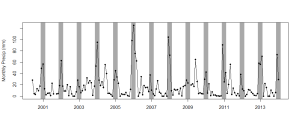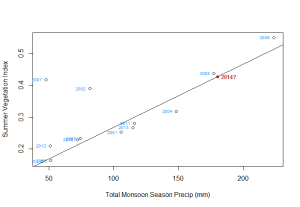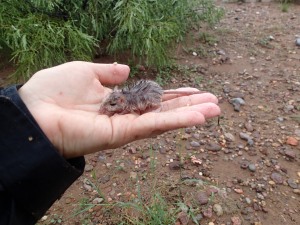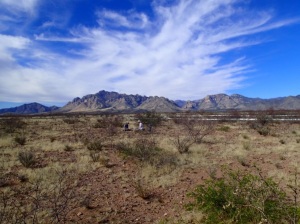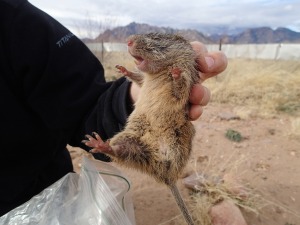In a previous post, I talked about a major trend over time at the Portal site: the slow and steady increase in shrub cover, which has gradually replaced the grassy landscapes of the 1970s. I also mentioned that this was accompanied by changes in the rodent species we caught: in the 1970s and 80s when shrub cover was still low, we found more individuals of grassland-loving species, whereas in recent years we see more individuals of shrub-loving species now that shrub cover is high. This seems like a straightforward story—species that love shrubs will become more abundant as shrubs cover more of the landscape—but it turns out there’s more to it. In this post, I’m going to describe how three pieces of evidence led me to questions about the dynamics of community change over time, and the new method I used to quantify it.
Evidence #1: the gradual increase in shrub cover + the change in species composition of the rodent community. Shrub cover has increased at least 3-fold since the time the Portal Project was established in 1977. Published studies have also noted that rodent species typical of arid grasslands have declined during that time (such as the banner tail kangaroo rat Dipodomys spectabilis and silky pocket mouse Perognathus flavus), while rodent species typical of arid shrubland have increased their populations (such as Merriam’s kangaroo rat Dipodomys merriami and desert pocket mouse Chaetodipus penicillatus). The obvious prediction is that the change in rodent species was caused by the change in shrub cover: however, so far all we have is a correlation, we would need more information to infer causation.
Evidence #2: the high mortality of rodents that occurred after a dramatic sheet flood swept through the Portal Project, during the monsoon season of August 1999. This is illustrated by the graph below, showing the relatively stable number of rodents at the site over the year and a half leading up to the storm, followed by their sharp decline.
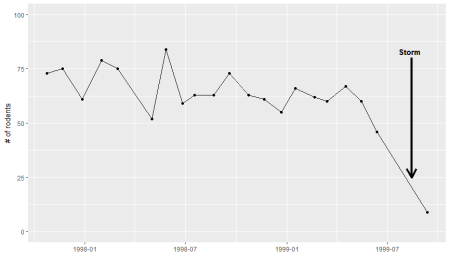
Total rodent capture numbers over time: showing sharp decline after a flood in August 1999
Evidence #3: Populations quickly bounced back after the sheet flood of 1999—but things were different. Within two months, researchers were catching numbers of rodents comparable to those before the flood. However, the community of rodents that re-assembled after the flood was not the same community that had existed before. While the identity of species present remained approximately the same, the relative abundances of these species changed drastically. Most notably, two species of pocket mice which had been rare up to this time (desert pocket mouse and Bailey’s pocket mouse, Chaetodipus penicillatus and C. baileyi respectively), rapidly increased their populations to become numerical dominants in the community. (Details of the flood and its effects can be found in Thibault and Brown (2008)).
The first chapter of my dissertation explores how these three pieces of evidence–an increase in shrub cover, an extreme weather event, and a shift in rodent community structure–are connected. Piecing these together, we have slow change in habitat that we believe is impacting the rodent community, a disturbance that proved catastrophic for the rodents at Portal, and a dramatic change in community structure. How can we put these together to describe the dynamics of this rodent community overall?
Did the transition from grass-loving to shrub-loving rodent communities occur slowly, following the slow change in habitat, or in a series of quick bursts (one of which happened in August 1999)? This is an important distinction to make, because it provides information about the mechanisms behind community change. If the rodent community is changing slowly with habitat change, this indicates that habitat is driving rodent community change.
However, if change occurs in quick bursts instead, it implies that habitat change is not the most important driver, and perhaps some sort of trigger is needed to facilitate change (like a flood). Furthermore, if we want to predict how this community (and others) will change in the future, we need to know when/if change tends to happen slowly vs. quickly. These concepts apply not only to the rodents at Portal, but to broad questions about community structure for many taxa.
The Research Question: is change in the Portal rodent community slow or fast? The graph below shows examples of patterns I might see in the rodent data if the community has been changing gradually, compared to changing through a series of quick bursts. Unfortunately, measuring how populations of 21 rodent species have changed over a span of 40 years, and in relation to one another, is not easy.
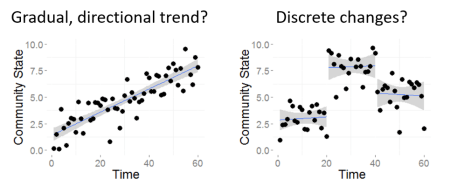
Gradual, or discrete?
The Method: On a suggestion from my colleague Dave Harris, I decided to borrow a technique from the field of document analysis, called Latent Dirichlet Allocation (LDA for short). Document analysts use LDA to look for patterns of words within documents. The algorithm identifies words that tend to be found together in a document (and the relative proportions of those words), and infers “topics” from those patterns. Each document can then be described in terms of the “topics” it represents. I co-opted this method to analyze patterns of species within sampling events. Given a table of counts of my 21 species captured in each sampling event (436 events in my case), LDA returns an estimate of which species are found together in specific proportions. I called these community-types instead of the “topics” used in document analysis. LDA then estimates how each sampling event is partitioned into these community-types. The result is that instead of describing each sampling event by listing how many of each of the 21 rodent species were caught, we can describe it in terms of a small number of community-types. For example, one of our samples might be that in January of 2015 we captured 35 Merriam’s kangaroo rats, 1 pack rat, 6 desert pocket mice, 6 Bailey’s pocket mice, 5 grasshopper mice, and 12 cactus mice. After running this data point (with all 435 other data points) through LDA, this information is transformed to say that the collection of animals caught in January 2015 was 80% similar to community-type 1 and 20% similar to community-type 2. (For a much more thorough description of the LDA method applied to ecological data, see Valle et al 2014).
The crucial part for answering my question: I am interested in measuring dynamics over time, so the part of the LDA results I am interested in is the description of each sampling event in terms of the community-types. The results of my LDA analysis indicated that the Portal rodent data set is best described with four community-types. In the graph below, I plotted the prevalence of these four community-types at each sampling event, illustrated with four different colors. When a color has a value near 1.00 (along the vertical, y-axis), for example as the “light blue” community does near the beginning (left) of the time series (x-axis), it means the rodent community captured at those sampling times was very similar to the community-type represented by that color.

Results of LDA analysis. Four colors represent four community-types.
Description of the results: The first thing that jumps out is that the four rodent community-types display different dynamics at different times. There are periods where the dynamics appear to be stable: for example the light blue community-type remains close to 1.0 from approximately 1977-1984, and the dark blue community-type is likewise close to 1.0 from 1990-1999. The dynamics from 2000-2010 are complicated: dark blue, gold, and gray community-types take turns as the most prominent community-type at different times (remember that the value on the y-axis represents how similar the rodent sample was to the given community-type at that time). Starting in 2010 there is a strong seasonal signal in the dynamics: the dark blue community-type is close to 1.0 during winters, and the gray community-type is close to 1.0 during summers.
Interpretation: The prediction I mentioned earlier, that change in the rodent community from one type to another might be gradual and in line with the gradual change in habitat from 1977-present, is not supported by our LDA analysis. Some sections of the time series seem to show gradual, linear change, but not the entire time series overall. Second, there are moments when there seems to be a rapid change from one community-type to another. For example, in the 1990s the rodent community samples were most similar to the dark blue community-type, until late 1999 when it was replaced by the gold and gray community-types. This fits with the evidence from Thibault and Brown 2008: the catastrophic flood in August 1999 that triggered an overhaul of the rodent community.
What’s next: This analysis hasn’t answered all the questions about how the rodent community at the Portal Project has changed over 40 years. But it’s a starting point, a big-picture view that we can use to identify different types of dynamics occurring at different times, and start to dig deeper into the causes of these dynamics. We know that communities and ecosystems all over the world are currently changing; understanding the factors that might be driving these changes is a huge step toward being able to predict and even manage future change, and the Portal Project is an example of how long-term studies with a lot of data can be used to explore these questions.
For more information: My paper describing the LDA analysis in full is available online as a preprint: “Long-term community change through multiple rapid transitions in a desert rodent community” at https://doi.org/10.1101/163931
Special thanks to Joan Meiners for editing help on this post.
Literature cited:
Thibault, K.M., and J.H. Brown. (2008). Impact of an extreme climatic event on community assembly. Proceedings of the National Academy of Sciences 105, 3410–3415.
Valle, D., B. Baiser, C.W. Woodall, and R. Chazdon. (2014). Decomposing biodiversity data using the Latent Dirichlet Allocation model, a probabilistic multivariate statistical method. Ecology Letters 17, 1591–1601.



